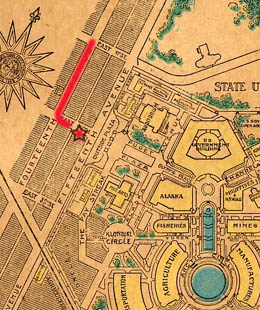On September 24, 1909, a Seattle Electric Company streetcar jumps the track at the corner of E 40th Street and 14th Avenue NE (later University Way). The streetcar crashes into three concession buildings across the street from the main entrance of the Alaska-Yukon-Pacific Exposition. One passenger, Frank Hull of Tacoma, is killed, and 55 men, women, and children are injured.
Off Track
The car had been carrying more than 80 visitors to the A-Y-P on its way from Wallingford when the brakes went out at 11:00 a.m., near the corner of E 41st Street and 14th Avenue NE. As the vehicle picked up speed on the downward slope of 14th Avenue NE, motorman E. W. Melendy yelled out to his passengers, “Brace yourselves, I can’t help you!” The car swung around the curve of the tracks at E 40th Street and derailed, traveling at approximately 30 miles an hour.
The 26-ton streetcar continued forward, smashing into a cigar stand and the St. Louis Café, behind which at the counter stood proprietor Edward Winslow and his assistant, Arthur Frye. Neither man had time to get out of the way. Both buildings were obliterated by the crash.
At this point the superstructure of the car separated from the wheels, which smashed into a third building. The rest of the vehicle, still carrying its passengers, flipped over onto its side and slammed into a telegraph pole, nearly tearing the car in half. The sound of the accident was heard well inside the fairgrounds.
A Fatal Revisit
At first, no moaning came from within the wreckage, and those approaching it thought that all inside might be dead, given the force of the crash. As soon as a few people staggered out, bystanders began tearing the vehicle apart, to rescue those trapped within. In less than 10 minutes, all passengers were accounted for, and it was determined that Frank Hull had died in the accident.
Hull was a member of the International Order of Odd Fellows and had attended the fair the day before, which was a commemorative day for the IOOF. Rather than return to Tacoma, he had decided to stay an extra day to enjoy more of the fair. He died from internal injuries. Hull was married and left behind a grown son and daughter.
The two men who were caught in the St. Louis Café when the streetcar smashed into it were badly injured, and although one local paper reported that Winslow was fatally wounded, he was only badly bruised with no broken bones. His assistant suffered cuts about the face.
Injuries Sustained
Some of the more badly injured passengers were carried into nearby businesses and homes, while others were taken by roller-chairs and rickshaws to the Exposition’s emergency hospital, under the care of Dr. W. C. Kantner. Dr. E. M. Rininger, medical director for the Exposition, arrived soon after, as did Dr. Park Weed Willis, who happened to be on the fairgrounds.
Amazingly, most of the injuries sustained were not serious. Most were bruised or cut by glass shards, but very few had broken bones. One woman had some teeth knocked out, and another suffered internal injuries. All were happy to be alive.
Soon after the accident, Seattle Electric Company president Jacob Furth (1840-1914) released a statement expressing sympathy for the victims, and offered prompt compensation for any of their injuries. Motorman Melendy told the press that when the brakes went out, there was nothing he could do but warn the passengers and pray.

